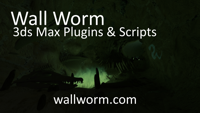Displacement Proxies
Displacement Proxies are geometry primitives that derive their geometry from the displacements in the scene. They do not get exported into a VMF (because the displacements they are derived from are already used in exports). Instead, they are useful as helper meshes for other systems (like being used with Particle Systems, Model bases, Forest surfaces and more) with the benefit of being able to reference displacement surfaces originating in XRef Scenes.
There are two kinds of displacement proxies that have different uses. Both kinds of displacement proxies can be found in the Command Panel > Create Tab > Wall Worm (Category Drop Down).
Displacement Proxy
This geometry object will derive its surface and UVs from all displacements used in the scene. This primitive is useful when you want to scatter objects on the entire scene with Forest. This primitive does not collect materials from the displacements.
Sculpt Proxy
The sculpt proxy will use the surface of a sculpt mesh in the scene. The sculpt mesh it uses is name-based--and if there are multiple sculpt meshes using the same name, it will use the first one it finds. This primitive can collect materials from the sculpt meshes.
Displacements in XRef Scenes
The primary purpose the sculpt proxies were created is to allow environment artists to access the surface of displacements that are located in XRef Scenes. Previously, it was not possible to reference displacements in another scene.
Example of Use
Here is an example use case. If the level designer is working with a scene that includes the brushwork and displacements, the environment artist can create a scene that uses the master level as an XRef Scene. In the artist's scene, the artist can create a sculpt or displacement proxy to use for placing props using advanced tools like Itoo's Forest Pro. By utilizing this method, the artist doesn't need to merge the main scene to get the displacements for use with Forest.
Another major usage that was used in production of Black Mesa was for culling props. See the more about the Convert Scene to Model tool.
- Related Topics





